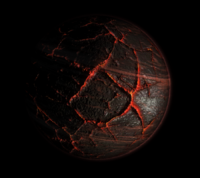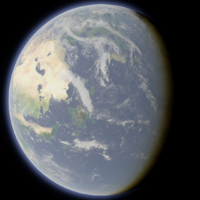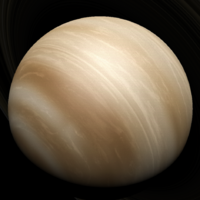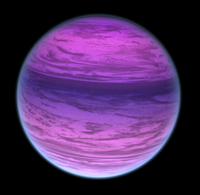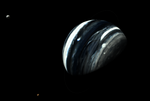Sanar System
 | |
| Age | 4.559 billion years |
|---|---|
| System mass | 1.0020 Sanar masses |
| Planetary system | |
| Semi-major axis of outer planet (Vanth) | 30.10 AU (4.503 billion km) |
| Distance to Kuiper cliff | 50 AU |
Populations | |
| Stars | 1 (San) |
| Planets | |
| Known dwarf planets | 2 (Disputed) |
| Orbit about Galactic Center | |
| Invariable-to-galactic plane inclination | 69.42°0 (ecliptic) |
| Distance to Galactic Center | 27,000 ± 1,000 ly |
| Orbital speed | 210 km/s |
| Orbital period | 225–250 Myr |
| Star-related properties | |
| Spectral type | G2V |
| Frost line | ≈5 AU |
| Distance to heliopause | ≈120 AU |
| Hill sphere radius | ≈1–2 ly |
The Sanar System is a collection of orbiting celestial bodies that are gravitationally bound to the San. The Sanar System began its formation 4.6 Billion years ago as a result of the gravitational collapse of a large interstellar molecular cloud. The vast majority of the Sanar System's mass is found within its star the San (99.80%), with the majority of remaining matter situated in the two gas giants of Satre and Diaphres. There are 12 to 14 planets in the Sanar System, with the status of Paidios and Pluta as either major planets or minor planets disputed within the scientific community.[1]
The seven Sanward planets (Hyperion, Balder, Eurth, Laran, Maraz, Petrus and Andreus) and the three outer planets (Paidios, Pluta, and Vanth) are terrestrial planets composed of rock, metals, and ices. The four remaining gaseous planets are significantly larger and more massive than the terrestrial planets, possessing the overwhelming majority of San-orbiting matter, primarily made up of gaseous elements and molecules. All inner terrestrial and gaseous planets have nearly circular orbits that lie on the ecliptic plane however the outer planets possess more eccentric orbits that intersect the ecliptic.
The planets of the Sanar System are classified either as the Sanward planets and the Sanway planets, or organised into three groups: inner planets, middle planets, and outer planets. The distinction between the two classifications comes down to whether the planets of Paidios and Pluta are either major planets or dwarf planets within an astronomical community. Most of the scientific community acknowledge Paidios and Pluta as planets in their own right, as their local orbits have been largely cleared of asteroids, though the Dust Belt they are a part of remains. Thus, the 3 groups planetary model is used the most in scientific literature.
Planets
| Name | Order | Mass (M🜨) | Radius (R🜨) | Density (g/cm3) | Semi-Major Axis (AU) | Orbital Period (🜨-Days) | Rotational Period (🜨-Days) | Major Natural Satellites | Discovery |
|---|---|---|---|---|---|---|---|---|---|
| San | 0 | – | – | – | – | – | – | – | Prehistoric |
| Hyperion | 1 | 0.139 | 0.485 | 6.74 | 0.0778 | 6.76 | 6.76 | n/a | 1860 |
| Balder | 2 | 0.237 | 0.878 | 1.93 | 0.673 | 202 | 2.23 | Nanna | Prehistoric |
| Eurth | 3 | 1.000 | 1.000 | 5.51 | 1.000 | 365.2425 | 1.000 | Mun | Prehistoric |
| Laran | 4 | 0.819 | 0.911 | 5.98 | 1.55 | 708.56 | 708.56 | n/a | $period |
| Maraz | 5 | 0.143 | 0.585 | 3.93 | 2.91 | 1813 | TBD | n/a | $period |
| Petrus | 6 | TBD | 0.385 | TBD | 4.59 | 3591 | TBD | Paulus* | $year |
| Andreus | 7 | TBD | 0.385 | TBD | 4.59 | 3591 | TBD | Paulus* | $year |
| Satre | 8 | 480.560 | 11.150 | 1.90 | 6.36 | 5843.84 | 18.01 | Albus | |
| Diaphres | 9 | TBD | 10.782 | TBD | 11.0 | 13324 | TBD | Apollo**, Nortia**, Maris, Artemis | $year |
| Ether | 10 | 30.809 | 7.254 | TBD | 20.1 | 40161 | 0.67 | Thalassa | 1802 |
| Thanatos | 11 | 18.282 | 3.94 | TBD | 38.7 | 87922 | TBD | Geras, Oizys, Moros, Apate | 1950s |
| Paidios | 12 | 0.0504 | 0.416 | 3.86 | 50.7 | 131883 | TBD | Mayanese | 1942 |
| Pluta | 13 | 0.00344 | 0.218 | 1.83 | 61.4 | 175844 | TBD | n/a | $year |
| Vanth | 14 | 0.671 | 0.866 | 5.31 | 84.4 | 283061 | 2.23 | n/a | $year |
*Petrus and Andreus are a co-orbiting binary pair with a P-type orbiting moon (Paulus).
**Apollo and Nortia are a co-orbiting binary pair that orbit Diaphres together.
San
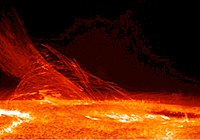
The San is the Sanar System’s singular star, with its mass accounting for over 99% of that of the Sanar System. Due to its massive size the core of the San is hot and dense enough to sustain nuclear fusion, releasing enormous quantities of energy that is radiated out into space heating up the planets and other celestial bodies in proximity. It is due to the San that life exists on Eurth.
Inner Sanar System
The 7 inner planets orbit the region from the San up to the Asteroid Belt. These planets orbit relatively close to the San and are rocky in composition, made up of silicate mantles and metal cores. The asteroid belt occupies the orbit between Petrus and Andreus and Satre. The sanward planets definition also covers the same planets.
Hyperion
Hyperion is the closest planet to San and was only discovered in 1860 by an Anglian astronomer ($NAME1) and later verified in Seylos and Tagmatium. The astronomical community at the time agreed to name it Hyperion, after the Aroman Titan of the San, as the name chosen by ($NAME1). Its late discovery is in part due to its incredibly tight orbit around San hiding it away from telescopes, leaving it a molten hellscape tidally locked to the star. Rapid silicon-vaporised winds erode what little landscape is left on the charred planet, with the planet expected to continue to migrate further inwards towards San and eventually be destroyed by tidal forces over the next billion years.
Several new age Christian sects have begun to call the planet 'Hell' or 'Hades' as the literal physical manifestation of the Underwurld. This Catholic Diarchy has been recorded in numerous instances as denying Hyperion as Hell as a place. The most recent recording was in 2018 when the Iverican Pope stated that: “Hyperion was made with the same hands God used to create the Eurth, it is no more damned than the soil you treaded into my Cathedral.”
Balder
Balder has always been visible to the naked eye in the night sky. However, its moon Nanna was only first recorded to exist in 300 CE by the Buranic tribes in north Argis, which is where both of their names come from as son and daughter-in-law of Woden/Oid respectfully. Balder is most well-known for its massive craters across its landscape, which were created 1.5 billion years ago when a dwarf planet collided with the young Balder, causing it to tip onto its side. The matter that was ejected into orbit eventually coalesced into Nanna. Although Balder itself is a prime target for future Human exploration due to its closeness to Eurth and low gravity, the proximity and size of Nanna makes calculating safe orbital trajectories incredibly difficult. Nanna's red colouration primarily comes from the high iron oxide content in its crust, and is the largest moon in ratio to its planet in the Sanar System.
Eurth
Eurth, also known as Earth (Anglish), Alemi (Oharic), or Aerta (Alemannisch), is the third planet from the San. It is the only heavenly body in the cosmos known to accommodate life. There are eight million types of animals and plants in the Wurld. Eight million different solutions to staying alive. Scientific analysis and radiometric determination have concluded that Eurth developed over 4 billion years ago. The Eurth rotates around the San in 365 and ¼ days, a period commonly accepted as Eurth year. The seasons are formed by the inclination of the rotational axis in the direction of the orbital surface.
Laran
Slightly smaller than Eurth, Laran has a magnetosphere and a ground soil composition similar to Eurth during the Archean period. However, it has one major difference: the planet is tidally locked. This likely happened after a massive collision early in the planet’s history. As a result, the side constantly facing the star is a massive desert, while the side facing away from the star is a frozen land. However, in-between these extremes, there are rings of potentially habitable areas with different climates depending on how warm they are. No macroscopic life has been confirmed. However, the planet's thin CO2 atmosphere suggests that if life does exist on the planet, it would have to be chemosynthetic microscopic organisms.
Maraz
Maraz's unique green and red colouration comes from the green and red iron rust across its surface, and the only known body to have Iron(III) chloride cations in high concentrations. This is due to Maraz having possessed a thick halogenic-CO2 atmosphere in the past, however by the present day it has been reduced to a trace green atmosphere. When telescopes were first invented, its green patches were mistaken for forests. Maraz became legendary in status from the 1600s until the mid 1900s, many considering it to be a planet bountiful in life. It was only with more powerful telescopes in the 1900s and the Easter Probe missions were the once-thought lush planet revealed to be the dead and dusty world it is now.
The planet is still an anomaly within the scientific community. The high concentrations of halogens in its past and present have yet to be explained. However, the leading theory comes from large volcanic eruptions in the planet's past releasing pockets of chlorine from Maraz's mantle.
Maraz is often used in Sci-fi alien invasion media (primarily films), with the first known piece of media to do some coming from the 1921 book Invasion of the Marazians and its 1939 radio sequel The Marazian Mutilation. In modern Sci-Fi the term 'Marazian' is often used to mean 'Extraterrestrial' with Marazians a common trope in Science Fiction.
Petrus and Andreus
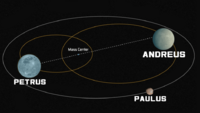
The most important and noteworthy property of these double planets is that they are binary planets. This means that Petrus and Andreus orbit each other around their barycentre and are roughly similarly sized. Their shared moon Paulus orbits around both of them in an elliptical shape. The planets should take 7.5 Eurth days to orbit around their barycentre, with their surfaces tidally locked to one another. Due to Petrus' surface possessing copper-rich rocks it possesses a surface with a unique shade of blue, whereas Andreus is covered in a thin layer of sublimating ice. This ice likely came from comets similar to those that gave Eurth its water.
Asteroid Belt
WIP
Middle Sanar System
The four middle planets orbit the Sanar region from the Asteroid Belt to the Dust Belt. The dust belt occupies the orbit between Thanatos and Paidios. The Dust Belt is a large circle of dust, similar to the Asteroid Belt, consisting mostly of icy objects. The Sanway definition also includes Vanth with the middle planets.
Satre
A gas giant and the first planet in the middle Sanar System. The planet is visually striking due to its massive ring system that extends 701,647 km out from the planet. This ring system is visible from Eurth’s skyline, with a size of 3 arcminutes at most and 2 arcminutes at least. Making it appear as large as 1/10th the size of the Mun at its closest.
Diaphres
WIP
Ether
Ether is the first planet discovered with a telescope and not known since antiquity. Although it is visible to the unaided eye, its planetary nature was not identified at the time because of its very weak brilliance and its very slow apparent movement in the sky. Indeed, before to be "discovered", Ether was considered as another star in the sky. It was on 9 September 1802 that the Lysian astronomer Armand Mûrat observed it for the first time. In the months that followed, astronomers confirmed that it was a planet and not a comet. Ether is named after the primordial god of the same name, Aether, who in Aroman mythology represents the warm and superior air breathed by the !Olympian gods and was inspired by Ether's ice blue colour. Ether's largest moon was named Thalassa after the primordial goddess of the sea, daughter of Eather and Hemera (primordial goddess of day).
The ice blue colour of Ether is explained by the presence of methane. Concerning the sea-blue stripes, according to the most widespread theory, these stripes are due to intense meteorological activity just beneath the outer atmosphere. Indeed, on Ether, clouds are composed of methane crystals, giving them a sea-blue colour. Thus, the stripes and spots appearing and disappearing on the surface of Ether are cyclones intensified by the speed of the winds (up to 600 m/s at the equator and up to 350 m/s at the poles), thus its often quite easy to date a particular picture of Ether just by the position and shape of its stripes and spots.
Ether has only one major satellite, which is unusually few for a gaseous giant. Ether's moon, Thalassa, was discovered two years after Ether was discovered. Thalassa is covered by a thick methane atmosphere that gives it its sea-blue colour. Ether's rings are mostly composed of ice and dust, ranging in size from a few centimetres to several tens of metres. The diameter of the rings is 375,000 km with the two main rings extending from about 87,000 km to 115,000 km from the planet's equator and being only a few tens of metres thick. These rings are usually only visible through specialised cameras or when the ring crosses directly between Eurth and Ether.
Thanatos
WIP
Outer Sanar System
Finally, the three outer planets / dwarf planets orbit the Sanar region from the Dust Belt to the outer reaches of the Sanar System and is the most controversial classification of planets.
Dust Belt
WIP
Paidios
Paidios comes from the Laimiaic for child (Paidi), this is because of Paidios’ very small size in comparison to the other planets of the Sanar system. The planet was first discovered by ($NAME2) in 1942, when technology and astronomy were advanced enough to discover the planet at its size and distance from Eurth.
The planet was initially thought to be a moon of its nearest planet, as their orbits at the time made it seem like they were next to one another, and this thought would be accepted until 1950 when a second verifiable observation proved that Paidios orbits independently around the San.
Paidios is incredibly far from San, having not yet completed a single orbit since its discovery. Paidios barely meets the size restriction to be classified a planet, and calls within the scientific community have drawn official bodies to review whether it should be considered a planet, or to expand the classification for Dwarf planet. The Delamarian Astronomic Association decided in 2006 that they would classify Paidios as a dwarf planet. However, this lead to major international public outcry, mostly by those without professional astronomic education, setting up international Paidios is a planet day on June 18th. And finally in 2011 the Association overturned its decision, classifying Paidios again as a planet. International Paidios is a planet day is still observed by many, especially in the scientific community, who despite their past have come to love the minuscule planet.
Only one spacecraft has ever drawn near to Paidios, the Conquistador IV, which passed and photographed the planet in 2017, so far those are the only close photographs of the planet.
Pluta
Pluta is perhaps the single most controversial talking point in astronomical circles, as it blurs the lines between a standard dwarf planet and the characteristics expected of a major planet. Pluta has met all 3 agreed upon definitions for a planet (orbits San, is spherical in shape, and has cleared its orbit of other celestial bodies that orbit the San) and yet is smaller than several identified dwarf planets which have not yet met major planetary characteristics. The Delamarian Astronomic Association still recognises Pluta as a dwarf planet despite reverting Paidios back to a major planet, but the Aurelian Astronomical Society recognises Pluta as a planet.
Vanth
The last planet in the Sanar System, but the oddest one, it is also the most distant planet in the system and the last to be discovered. It’s a rocky-ice planet, but despite its terrestrial size and composition, the planet has an orbit vastly different from that of the rest of the planets, being more eccentric and inclined than even Pluta and Paidios. It has been accepted in most astronomical circles that Vanth is not of this star system, but instead comes from a different star system. Many other minor planetary bodies also possess similar orbits to Vanth, suggesting they also come from the same star system as Vanth (or were once moons of Vanth). How Vanth came to be a part of the Sanar System is entirely unknown. The two main theories posit that it was either flung out by another star system in the San's celestial neighbourhood, or was captured in a close encounter with another star system.
Very little is known about the planet's characteristics, and no space probe has thus far come close to Vanth to picture its surface. All current images of Vanth are blurry, showing only the largest geographical features on the planet. The most disturbing features are planet-sized cracks across the planet's surface with no signs of an impact crater large enough to create them, suggesting the cracks are geomorphological in origin.
Dwarf planets
Within the Dust Belt there are numerous recognised Dwarf Planets and several hundred unclassified minor planetary bodies.
The largest Dwarf Planets are the Nachtgeschwister binary dwarf planets called Nacht-A and Nacht-B, both of which are larger than the planet Pluta. Their eccentric inclined orbits are very similar to the planet Vanth, suggesting similar origins as extrasolar objects. The Nacht dwarf planets were discovered on 2 April 2005. Since records began in 2005, it has been noted that the distance from the dwarf planets to their barycentre have begun to shorten exponentially, with the dwarf planets predicted to collide sometime in late 2024. This perturbance of their orbits causing them to become unstable likely came from a chance close encounter with another dwarf planet in the Dust Belt.
The Nachtgeschwister in modern times are more well known for their connections to the Sentist State's religious cosmology as the embodiments of gods Elkatoth and Selvios. Within the Sentist religion it is described that when Nacht-A (Elkatoth) and Nacht-B (Selvios) collide, the deity Xelnitorath will come to Eurth. All attempts to recognise the names Elkatoth and Selvios for the Nachtgeschwister binary dwarf planets have been rejected by all respected scientific astronomical societies. Other new age religions have marked the collision of the Nachtgeschwister as the sign of the end times, usually by exaggerating the chance likelihood of Eurth being impacted by debris released from the collision of the two objects. The CAOS Space Program, Seylosian Space and Aeronautics Administration, and Delamarian Astronomic Association have determined that the increased likelihood of Eurth being impacted by asteroids in the next millennia by the Nachtgeschwister collision is negligible.
Celestial neighbourhood
WIP
Exploration of the Sanar System
WIP
History of human perspective
Around 650 BCE, most people believed the Eurth was flat with a sky hanging above it. It wasn't until Classical philosopher Proximander (c. 620 – c. 550 BCE) came along that people began to see that the sky was surrounding us. Later, Aroman philosophers hypothesised that the San, Mun, planets and stars revolved around the Eurth. Humanity held this Eurth-centric view of the universe until the Post-Classical Era. This is when Victor Bronzicus (1464–1523) theorised that the San was really at the centre, with the Eurth, stars and planets revolving around it. Eventually, the scientific establishment accepted his argument. By the early 20th Century, astrophysicists discovered our galaxy to be part of an immeasurably larger cosmic design than what previously thought. Eurth is a mere dust cloud in a universe of galaxies. Then came Hana Sitayini (1897–1966), whose work showed a curved universe. Prior to that, people believed it was flat. She posited that its wavy surface even collected mass so dense as to create canyons, later known as black holes. This leads us to the present-day recognition of a gradually expanding universe, whose extraordinary origin shaped the life we know today.
Space exploration
WIP
References
- ↑ Sanar System 2021 December Contest (3 December 2021)
